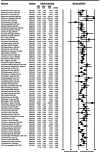A call to action for delirium research: Meta-analysis and regression of delirium associated mortality
- PMID: 32894065
- PMCID: PMC7487610
- DOI: 10.1186/s12877-020-01723-4
A call to action for delirium research: Meta-analysis and regression of delirium associated mortality
Abstract
Background: Delirium is an extremely common hospital complication. No study to date has assessed whether a priori defined covariates; type of hospital setting and year of study publication, influence the relationship between delirium and mortality. This is also the first study to examine the longitudinal trend of delirium-associated mortality over recent decades, to analyse the trajectory of our efforts in combating this disease.
Methods: MEDLINE, EMBASE and PsycINFO, were searched from January 1981 to May 2018 for English-language primary articles. Rigorous title and abstract screen and full-text screen were conducted independently by two reviewers. This paper adhered to MOOSE guidelines. Data was extracted independently by one reviewer using standardised data-collection sheets, with a separate reviewer verifying for accuracy. The quality of included studies was assessed using the Newcastle-Ottawa Quality Assessment Scale. Unadjusted effect sizes and event counts were analysed with a random effects model in primary meta-analysis and meta-regression, whereas a mixed effect model was used in secondary sub-group analysis. Mortality data at longest follow-up and cumulative mortality (hospital mortality combined with mortality at longest follow-up) data were analysed.
Results: As part of a larger project, 446 of 6790 articles were retrieved, including 71 studies that measured mortality. Our results demonstrate that elderly inpatients with delirium had significantly greater odds of mortality (OR 3.18 [95%CI: 2.73, 3.70]) compared to non-delirious controls. Patients with delirium in the ICU had the highest odds for mortality (OR: 7.09 [95%CI: 3.60, 14.0]); double the risk compared to the average. Curiously, despite advancements in delirium research, delirium associated in-hospital odds of mortality has not changed in 30 years.
Conclusion: This is the largest meta-analysis to confirm the association between delirium and mortality, in older (age ≥ 65) hospital inpatients. The current meta-analysis highlights the significant odds of mortality after an episode of delirium, and these odds are much higher for ICU patients. However, in contrast to other medical conditions that have seen a decrease in associated mortality over the past few decades, delirium associated mortality remains unchanged. These findings underscore the urgent need for better delirium treatments. PROSPERO Registration Number: CRD42018098627, https://www.crd.york.ac.uk/prospero/display_record.php?RecordID=98627.
Keywords: Acute confusion; Death; Delirium; Mortality; Prognosis.
Conflict of interest statement
The authors declare that they have no competing interests.
Figures




References
-
- American Psychiatric Association . Neurocognitive Disorders. Diagnostic and Statistical Manual of Mental Disorders. DSM Library: American Psychiatric Association. 2013.
-
- Inouye SK, van Dyck CH, Alessi CA, Balkin S, Siegal AP, Horwitz RI. Clarifying confusion: the confusion assessment method. A new method for detection of delirium. Ann Intern Med. 1990;113(12):941–948. - PubMed
-
- Bellelli G, Nobili A, Annoni G, Morandi A, Djade CD, Meagher DJ, et al. Under-detection of delirium and impact of neurocognitive deficits on in-hospital mortality among acute geriatric and medical wards. Eur J Int Med. 2015;26(9):696–704. - PubMed
-
- Devlin JW, Fong JJ, Fraser GL, Riker RR. Delirium assessment in the critically ill. Intensive Care Med. 2007;33(6):929–940. - PubMed
Publication types
MeSH terms
LinkOut - more resources
Full Text Sources
Medical
Research Materials
Miscellaneous

